Emma Watson Beauty and the Beast
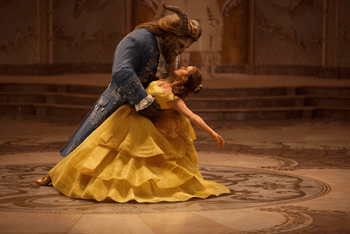
Emma Watson Beauty and the Beast
Cast: Emma Watson, Dan Stevens, Ewan McGregor
Director: Bill Condon
Genre: Family, Fantasy, Musical
Rated: PG
Synopsis: Disney's 'Beauty and the Beast" is a live-action adaptation of the studio's animated classic which refashions the classic characters from the tale as old as time for a contemporary audience, staying true to the original music while updating the score with several new songs.
Beauty and the Beast
Release Date: March 23rd, 2017
Trailer
Facebook: WaltDisneyStudiosAUNZ
Twitter: @DisneyStudiosAU
Instagram: @DisneyAUNZ
About The Production
The story and characters audiences know and love come to spectacular life in Disney's 'Beauty and the Beast," a live-action adaptation of the studio's animated classic featuring an extraordinary ensemble cast, including: Emma Watson, Dan Stevens, Luke Evans, Kevin Kline, Josh Gad, Ewan McGregor, Stanley Tucci, Audra McDonald, Gugu Mbatha- Raw and Nathan Mack with Ian McKellen and Emma Thompson.
Directed by Bill Condon and based on the 1991 animated ï¬ lm 'Beauty and the Beast," the screenplay is written by Stephen Chbosky and Evan Spiliotopoulos. Alan Menken provides the score, which includes new recordings of the original songs written by Menken and Howard Ashman as well as three new songs written by Menken and Tim Rice. The ï¬lm is produced by Mandeville Films' David Hoberman, p.g.a. and Todd Lieberman, p.g.a with Jeff rey Silver, Thomas Schumacher and Don Hahn serving as executive producers.
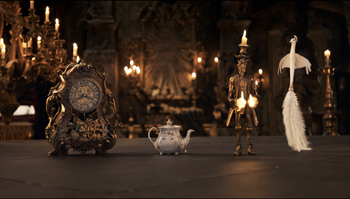 The Tale as Old as Time
The Tale as Old as TimeOnce upon a time there was a dashing young Prince (Dan Stevens) who lived in a magniï¬ cent castle. He hosted extravagant parties attended by beautiful debutantes from around the world and was pampered by a staff of servants who tended to his every whim, but the Prince had become insolent and self-absorbed. When an old beggar woman appears at the castle seeking shelter from the storm and offers him a single rose in return, he callously turns her away, unaware that she is, in fact, a beautiful enchantress. To punish him for his cruelty, she places a curse on the castle, transforming him into a Beast and all its inhabitants into household objects. To reverse the spell, he must learn to love another and be worthy of their love in return before the last petal of an enchanted rose falls…otherwise, he will remain a beast and his staff their inanimate forms, imprisoned in the castle for all eternity.
Some years later in the small town of Villeneuve, Belle (Emma Watson), a bright and spirited young woman, goes about her daily chores, pondering the monotony of her provincial life. Fiercely independent and preferring to keep to herself for the most part, Belle lives with her father, Maurice (Kevin Kline), a reclusive artist, and is an avid reader who dreams of adventure and romance in a world far beyond the conï¬nes of her French village.
The town's residents, however, are unsure what to think of her, for as virtuous and kind as she is beautiful, Belle remains a complete enigma. She rejects the relentless advances of the arrogant and boorish rogue, Gaston (Luke Evans), who holds court in a country inn with his sidekick LeFou (Josh Gad) and has every eligible woman in town wrapped around his ï¬nger. Gaston is smitten with Belle, but she is strong-willed and remains impervious to his charms.
When Maurice sets off for the market and is attacked by wolves, becoming lost in the woods, he stumbles upon the Beast's castle, now darkened and iced over, where he takes refuge. But the Beast is enraged to ï¬nd him trespassing and takes him prisoner. Belle learns of her father's disappearance and sets off in search of him, coming face to face with the Beast, with whom she pleads for his release, eventually trading her own freedom for her father's. While locked away in a tower of the ominous castle, Belle hears friendly voices – those of the enchanted household objects, who can now speak as a result of the spell. She is introduced to the former members of the castle's staff, including: Lumière (Ewan McGregor), a candelabra; Cogsworth (Ian McKellen), a mantel clock; Mrs. Potts (Emma Thompson), a teapot; Madame de Garderobe (Audra McDonald), a wardrobe; Plumette (Gugu Mbatha-Raw), a feather duster; and Maestro Cadenza (Stanley Tucci), a harpsichord. Hopeful that Belle may ï¬nally be the one to capture the heart of the Beast, they watch and wait for any signs of true love, but the Beast is surly and ill-mannered and has come to accept his fate.
Given their conflicted relationship, rife with animosity and resentment, romance appears out of the question, but Belle has a loving nature and the ability to see what other people cannot and begins to sense the kind heart of the Prince within. The Beast can be generous, sharing his library with her, and chivalrous, placing his life in danger to protect her, and he makes her laugh. Belle is courageous, fearlessly standing up for herself, and compassionate, nursing the Beast's wounds when he is injured on her behalf. Together, they enjoy reading and discussing works of literature…she inspires him to become a better person, and he slowly begins to come back to life.
Beauty Comes From Within
The classic tale of 'Beauty and the Beast" – and its empowering message that true beauty comes from within – dates back to 18th century France and the ï¬rst published version of the fairy tale, 'La Belle et la Bête," by Gabrielle-Suzanne Barbot de Villeneuve. Today, the themes are still just as relevant and the story continues to enthrall storytellers, resulting in countless interpretations across all forms of media, but it is Disney's Oscar®-nominated animated ï¬ lm from 1991 which has been the deï¬ntive version.
One of the studio's most treasured titles, 'Beauty and the Beast" was released during Disney's second golden age of animation, along with 'The Little Mermaid," 'The Lion King" and 'Aladdin," among others, and was immediately hailed as a cinematic masterpiece. As spellbindingly romantic as it is comedic, 'Beauty and the Beast" is an unforgettable tale of love and friendship that transports readers to a magical fairy tale world where good triumphs over evil.
'Beauty and the Beast" was the ï¬rst animated feature to receive an Academy Award® nomination for best picture and won two Oscars® (best original score and best song), three Golden Globes® and four GRAMMY®
Awards, among a multitude of other awards. The ï¬ lm was the ï¬rst animated feature to gross more than $100 million at the box office in its initial release and the ï¬rst Disney animated feature to become a stage musical production, one which subsequently ran on Broadway for 13 years and was translated into eight languages, playing in over 20 countries.
The studio felt an adaptation of the story of a kindhearted maiden and her beastly prince had the potential to enchant audiences once again, but when the studio pitched the idea to Bill Condon, his initial fear was remaking something that is flawless as is. 'I consider the 1991 ï¬lm to be a perfect movie," Condon says. 'When the ï¬ lm was released it was groundbreaking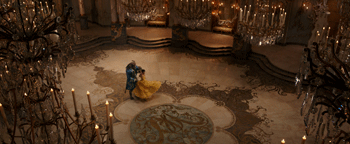 , in the way the story was told and with that incredible score from Alan Menken and Howard Ashman, so I initially did not want to go near it."
, in the way the story was told and with that incredible score from Alan Menken and Howard Ashman, so I initially did not want to go near it."
'Now it is possible, for the first time, to create a photo-real version of a talking teacup on a practical set in a completely realistic live action format."
For the director, the allure of 'Beauty and the Beast" was twofold: It was a chance to make a movie musical that is a tribute to the musicals from the Golden Age of Hollywood, and an opportunity to revisit a story he connects with emotionally and to dig deeper into the characters to ï¬nd out what makes them tick. The director has an encyclopedic knowledge of musicals and a clear understanding of how story and music converse with one another, and saw the ï¬ lm as a chance to bring back the musical genre.
He explains, 'When I was growing up people would say theater was dying, and theater has been dying for centuries now. I think the same thing can be said about the movie musical, not for centuries, but it has sort of been dying for the last 50 years. I want audiences to embrace the form and understand that, at its best, music and movies and musical numbers in movies don't distract, they don't interrupt, they deepen and help create meaning. If you're moved by something, you're more moved when you hear some of those Alan Menken notes or hear some of those Howard Ashman lyrics."
Emma Watson says, 'Any time I hear music from -Beauty and the Beast,' it connects me with that childlike feeling that everything is going to be okay and that there's hope in the world, and it just gives me this sense that everything's ï¬ne."
According to Academy Award®-nominated producer David Hoberman ('The Fighter," 'The Muppets"), 'Bill was 3 the perfect choice. He has an intimate knowledge of the fairy tale -Beauty and the Beast' going back to the first written version, he is a big fan of acclaimed French director Jean Cocteau's 1946 avant garde take on the story and he has seen the Broadway production multiple times, so he was already an aï¬cionado."
Working with co-screenwriters Evan Spiliotopoulos ('The Huntsman: Winter's War," 'Hercules") and Stephen Chbosky ('The Perks of Being a Wallfl ower," 'Rent"), Condon set out to expand upon the story's timeless themes and add more depth and dimension to the familiar characters while still celebrating the animated ï¬ lm and its legacy. 'There have been some recent movies that have been top to bottom reinventions or stories as seen from another character's point of view or something," he says. 'This is not that. What we wanted to do was bring the story more into reality, not create a new story."
He continues, 'It is an honor to have a chance to create something that is both reverential of the original and somewhat of a modernisation at the same time, but it is also intimidating. This is a story that has lived in many forms and in many languages, and to have an opportunity to work with state-of-the-art technology and an amazing cast is such a blessing. I hope that, because this movie is so loved, we'll be able to answer questions that fans may not have even realized they had about Belle and about the Beast speciï¬cally, and how they came to be who they are today."
The ï¬lm offers a glimpse into the Prince's life before he became the Beast and what turned him into a man who deserves to be cursed. It also expands on Belle's life before she goes to the castle and meets the Beast and helps explain what the two have in common and what made them who they are today.
Woven into the fabric of the story are outstanding new songs from eight-time Oscar®-winning composer Alan Menken ('The Little Mermaid," 'Aladdin," 'Pocahontas") and veteran lyricist and three-time Oscar winner Tim Rice ('The Lion King," 'Evita"), and because Condon is a fan of musical theatre and knows all the songs and musical references, it made Menken's job that much easier. 'Bill really knows his stuff," says the composer, 'So we were able to begin working with a lot of tools already at our disposal and a lot of reference points we could discuss immediately. Bill is a micromanager in the best sense of the word because he is genuinely concerned with each element in the story and the music."
The Beloved Characters
Director Bill Condon brings a deep understanding and respect for the actors he works with, and collaborating with them in the initial stages to ï¬ ne-tune the personal details of their characters is a process he ï¬nds invaluable. In this case, weeks of one-on-one work with actors led to a full- script table read, a customary practice Condon orchestrates – though in this case, with some musical numbers fully performed by actors and ensemble – it turned into more of a live concert for the assembled crew. 'Bill Condon decided to put on a show and I've never seen or heard anything like it," remarked Ian McKellen just afterwards. The cast agreed it got the production off to a great start, and exempliï¬ed what this unique experience would have in store.
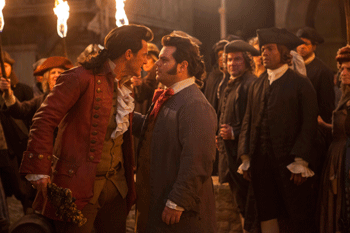
For over a decade, the British actress has charmed audiences playing the quick-witted and tenacious Hogwarts student Hermione Granger in the 'Harry Potter" films and in films including 'The Perks of Being a Wallflower," 'Noah" and 'The Bling Ring." In addition, she has a highly-visible role as a human rights activist and global goodwill ambassador for the United Nations, something which has become her life's calling. Of all the female characters in all the Disney films, she has always been drawn to – and most identiï¬es with – Belle.
'I have loved -Beauty and the Beast' since I was four years old," she says. 'I remember Belle as this feisty young woman who spoke her mind and had these ambitions and was incredibly independent and wanted to see the world. And she had this relationship with the Beast where they were just toe to toe and that, to me, just seemed like such a terriï¬c dynamic and interesting kind of relationship that I'd never seen before in a fairy tale."
Prior to 1991, most female characters in animated films were viewed as passive and somewhat one-dimensional, but Belle broke the mold. She is interested in literature, has thoughts of her own and is not easily intimidated, and quickly became an empowered role model for girls around the world and the first contemporary feminist heroine in an animated ï¬ lm. 'Belle is someone who doesn't really care about becoming a princess," says Condon. 'She's more interested in seeing the world and ï¬guring out who she is than in ï¬nding a man and getting married."
Not only does Belle herself love reading, but she also loves sharing her passion for books. Says Bill Condon, 'We all know how intelligent and worldly and sophisticated Emma Watson is, and while that doesn't describe Belle, it is what Belle aspires to be, and it is the innate intelligence that Emma Watson brings to the role that is such a crucial element when you're doing a live-action ï¬lm."
Of particular importance to the ï¬lmmakers was determining the ï¬ ne line between man and beast, as there are moments when rage overwhelms the character and makes him more beastly, yet there are other times when he is quite gentle. 'Bill Condon and I spent a lot of time talking about how we could add some nuances to my character to make him more dimensional than the Beast from the animated ï¬lm," says Stevens. 'It was quite interesting, trying to ï¬nd those little human beats that would make him less animalistic and more a human trapped inside this creature."
Says Bill Condon, 'I'm a big fan of Dan's…he's got this amazing range. Taking this part on was taking on a lot more than just playing a role because of all the incredibly complicated technical things he had to face and the trust he had to place in everyone around him that all that work he did would shine through in the end. It takes a certain kind of character to be willing to do that."
'The role is an incredibly challenging one, as Dan has to bring the Beast to life even though he is represented on screen digitally," adds producer David Hoberman. 'The Beast is a fully-digital character created through performance and facial capture technology, and Dan is able to beautifully convey both the Beast's humanity as well as his beastliness."
Stevens also had several profound discussions with Emma Watson as to the mindset of their characters and the balance between good and evil and masculinity and femininity. He explains, 'I was very keen on trying to calibrate the Beast according to the Belle that she wanted to be and to play, and we ultimately ended up realizing that this tale is not so much about beauty and ugliness but about the beauty and the beast that live in all of us and learning to live with that balance."
For the roles of the egotistical village heartthrob Gaston and his bumbling sidekick LeFou, the ï¬lmmakers were concerned the parts would be difficult to cast. With popular characters like these from the animated ï¬ lm, it was important they transition into human characters the audience would ï¬ nd believable in a real-world environment. The screenwriters bestowed Gaston with some new characteristics to make him appear more contemporary and credible, fashioning him to be a war hero who saved the town from invaders and someone who is easily provoked. Bill Condon explains, 'With a short temper, he can easily lose control when anyone or anything crosses him, which became an interesting way to take something that was cartoonish and turn it into something real."
The character of LeFou, who provided much of the comic relief from the animated ï¬ lm, was given some slight nuances as well. 'He used to be sort
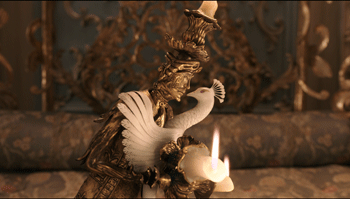 of a punching bag," says Bill Condon, 'And that's just not funny or interesting or credible in live-action, but I think we were able to ï¬nd the right balance."
of a punching bag," says Bill Condon, 'And that's just not funny or interesting or credible in live-action, but I think we were able to ï¬nd the right balance." Fortunately, casting the two characters turned out to be anything but difficult. Welsh actor Luke Evans ('The Girl on the Train," 'The Hobbit: The Desolation of Smaug") was the embodiment of Gaston, the shallow and arrogant villager intent on marrying Belle. The actor is even an accomplished vocalist, having starred in a number of West End stage productions, and Gaston has a substantial amount of singing in the ï¬ lm ('Gaston," 'Belle" and 'The Mob Song").
'Here's the thing about Luke Evans," says Bill Condon. 'He has all the qualities that are right for Gaston but he has this other thing which comes from years of working on a stage and which is so important to have in a movie musical, and that's the joy of performing. This is a role he was born to play."
In discussing his character Luke Evans says, 'Gaston doesn't see the world the way everyone else sees it. He's at the top of the pyramid and everyone else is below him. He thinks he can do no wrong and does not understand why Belle does not want to be his wife. I mean, God, is she mad? Is she blind? Is she stupid? He doesn't get it, which is funny in and of itself, so I really tried to play up the comedic aspects."
'I haven't done a lot of comedy," he continues, 'But it's been fun to play Gaston and be able to bounce off the likes of Josh Gad, a very accomplished comedian with perfect timing."
Josh Gad, perhaps best known as the voice of Olaf in the box office phenomenon 'Frozen," is LeFou, Gaston's long- suff ring aide-de-camp. While not the brightest bulb in the box, LeFou worships Gaston, even though Gaston has no regard for him whatsoever and makes him the brunt of most of his jokes. Gad, who is also a veteran of musical theatre, having starred on Broadway in the Tony Award®-winning musical 'Book of Mormon," hit it off with Evans immediately, clearly evidenced by their chemistry on screen. Together they were able to bring a good deal of humor to what are, essentially, villainous characters.
'Gaston is this very central ï¬gure in their village," explains Josh Gad, 'And LeFou is like a historian celebrating Gaston's legacy who is always there to remind the public how important his contributions were. If Napoleon Bonaparte had a sidekick, it would be LeFou."
Gad appreciated Bill Condon's dedication to making the characters more fully-realised individuals. 'Bill Condon is a very intimate director," he says. 'So many of his films have an intimacy to them, so to do a big tentpole ï¬lm like this with these incredible sets and to have someone like Bill Condon who grounds it all with these amazingly fleshed-out characters and ensures that the intimate moments are what the audience has the biggest emotional response to, has just been a tremendous experience."
Maurice, Belle's father, is played by Oscar® and two-time Tony Award® winner Kevin Kline ('The Ice Storm," 'In & Out"). The character was a wacky inventor in the animated ï¬ lm but is now an artist specializing in beautiful one-of-a-kind music boxes, which to Belle represent the world beyond the conï¬nes of Villeneuve and to Maurice a way to remember a moment in his life that was perfect but now gone.
'Like so many others, I've loved Kevin Kline forever." says Bill Condon. 'I also remember him as a musical performer when he was very young, so to get him singing again was very exciting for me as a director. But more than that, much more than that, all the deeper stuff, the sense of loss and fear for Belle, all that is really so beautifully captured by Kevin."
As an actor, Kevin Kline likes to immerse himself in his characters and was curious as to how Maurice would have made the music and the mythology behind music boxes. He also spent a good deal of time speaking with Condon, Stevens and Watson walking through all their scenes and adjusting and incorporating new ideas, which helped him to ï¬gure out, in concise ways, how to communicate more about who his character is.
Two-time Golden Globe® nominee Ewan McGregor ('Moulin Rouge," 'Star Wars: Episode I – The Phantom Menace") is Lumière, the Prince's proper French valet turned candelabra. Frequently at odds with Cogsworth and besotted with Plumette, it is Lumière who sings the show's most extravagant musical number, 'Be Our Guest." The actor was unfamiliar with the song when he first arrived on set, but quickly became a fan, delivering a performance that would have made Maurice Chevalier proud.
'Ewan brings a bit of that -Moulin Rouge' kind of joy to this character," says Bill Condon, 'And there's something so infectious about the way he sings, and sells, the song."
It had been decided early on in the writing process to expand the story's prologue and add a new character, a maestro who, along with his diva, is performing for the Prince at his castle when the spell is cast. Academy Award® nominee and two-time Golden Globe®-winning actor Stanley Tucci ('Spotlight," 'The Hunger Games") was cast as Maestro Cadenza, now a harpsichord, and Cadenza's wife, the renowned Italian opera diva Madame de Garderobe, is played by six-time Tony Award® and Emmy® winner Audra McDonald ('Ricki and the Flash," 'Private Practice"). The curse transforms her into an enormous wardrobe in Belle's bedroom at the Beast's castle, the same room where she had previously stayed herself, when she was the visiting opera singer. Garderobe has a fl are for melodrama and a proclivity for frequent naps.
Gugu Mbatha-Raw ('Miss Sloane," 'Beyond the Lights,") is Plumette, the cheeky maid turned elegant feather duster. 'Lucy Bevan, our casting director, suggested Gugu to us," says Hoberman, 'And while she may be one of the most beautiful women in the world, she also has a fantastic voice. She is the perfect Plumette."
Making his musical theatre debut at the age of 76 is two-time Oscar®-nominated and Tony Award® and Golden Globe®-winning actor Ian McKellen as Cogsworth, the fastidious and tightly-wound head butler who is transformed into a mantel clock. While best known to younger audiences for his roles in 'The Lords of the Rings" trilogy (Gandalf) and the 'X-Men" films (Magneto), he is also a classically- trained actor with a wealth of Shakespearean credits under his belt.
It was Bill Condon, having worked with him in the past on films including 'Gods and Monsters" and 'Mr. Holmes," who reached out to his friend to offer him the role, and Ian McKellen was all too eager to come on board. 'When a script comes to you in the mail and you see that it is from Bill Condon, you say, -Yes,' even before you've read it," laughs Ian McKellen.
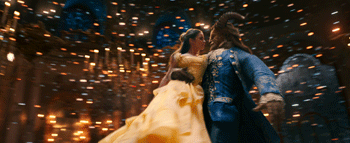
He continues, 'One of the first films I remember seeing was Cocteau's -La Belle et le Bête,' and I remember the excitement and the rather primitive technology used when the Beast sheds his hair and turns into the beautiful Jean Marais as the Prince. Bill is the ideal choice for a story like this. He loves musical theatre and he likes the spectacle and energy of a big production that has music and dancing, and this is musical cinema. But at the same time, he recognizes the delicacies of human behavior."
Two-time Academy Award® and Golden Globe® winner Emma Thompson ('Sense and Sensibility," 'Howard's End") joined the cast as Mrs. Potts, the Cockney housekeeper who becomes a teapot and takes Belle under her wing, and the actress has nothing but praise for her director. 'Bill is so wise and funny and kind and tender," she says, 'And he's assembled the best group of people because he is one of the best. You just know that this ï¬lm is going to be witty without being too sentimental and is going to have pace and verve and vigor and life and is going to mean something, because that's just who he is."
Dan Stevens conversed with Emma Thompson about the relationship between the Beast and Mrs. Potts, and says, 'Mrs. Potts is the closest thing the Beast has to a mother ï¬gure, really. She's a bit like his strict aunt; she keeps him in line, keeps him in check, and it was nice to chat and establish that between ourselves."
The ï¬lmmakers reasoned that if anyone could take on the legacy of a character created by Angela Lansbury, it was Emma Thompson, as she has a similar warmth, history and connection to an audience. Coincidentally, Emma Thompson arrived on the set of 'Beauty and the Beast" straight from a sold-out run of 'Sweeney Todd" in London, in which she played Mrs. Lovett, a role Lansbury originated on Broadway.
Newcomer Nathan Mack plays Mrs. Potts' son, Chip, who is now a teacup, and Haƫe Morahan ('Alice Through the Looking Glass," 'Mr. Holmes") is the enchantress who places the spell on the Beast and his castle at the beginning of the story.
An Enchanted 18th Century Setting
Principal photography on 'Beauty and the Beast" took place at Shepperton Studios outside London and on several exterior locations in the U.K. from May to August, 2015. Shepperton, whose production stages have played host to such films as 'Lawrence of Arabia," 'Oliver!" 'Gandhi," 'A Passage to India" and 'A Clockwork Orange," was the ideal location for a production of this scope and magnitude as it features an enormous backlot and plenty of stages on which to build multiple large-scale practical sets, of which 27 were needed in total.
While the story unfolds in a live-action format, there is still a substantial amount of animation and computer- generated imagery required, and it was important for the ï¬lmmakers to shoot on as many realistic-looking environments as possible, as the massive and elaborately designed and detailed sets help to differentiate this ï¬lm from the animated version. These practical sets were also scanned into a computer and turned into a digital 3D format to digitally create the visual movie (pre-vis) before shooting began to help map out camera positioning and lighting.
The talented team of artists tasked with visually bringing the animated ï¬ lm to life include: director of photography Tobias Schliessler, ASC ('Mr. Holmes," 'Lone Survivor"); four-time Oscar®-nominated production designer Sarah Greenwood ('Hanna," 'Atonement"); ï¬ lm editor Virginia Katz, ACE ('Dreamgirls," 'Burlesque"); Academy Award®-winning costume designer Jacqueline Durran ('Macbeth," 'Anna Karenina"); four-time Oscar-nominated set decorator Katie Spencer ('Sherlock Holmes," 'Pride & Prejudice); Oscar-winning make-up and hair designer Jenny Shircore ('Elizabeth, 'The Soloist") and casting director Lucy Bevan ('Alice Through the Looking Glass," 'Cinderella").
In a fitting tribute to the story's notion of female empowerment, all the department heads on the design team – many whom are frequent collaborators of director Bill Condon – are female, as was the ï¬ lm editor and the casting director, and all are at the top of their game creatively. Greenwood and Spencer have worked together for almost two decades and both have worked with Durran and Shircore before, and each was passionate about the project, sharing ideas and information between the other department heads, which helped to create seam
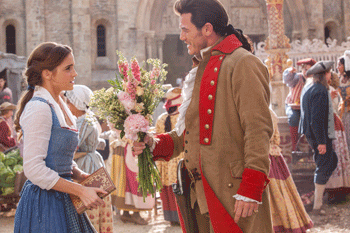 less integration.
less integration. As production designer, Greenwood is essentially in charge of every visual aspect of the ï¬lm, and with 'Beauty and the Beast" she was striving for a timeless, European feel in the tradition of the great Hollywood romances. The story is set in a speciï¬c time and place – mid-18th century France – as opposed to an undated alternate fairy tale universe, and while each department's work was influenced, in part, by the 1991 animated ï¬ lm, the sets, props, costumes and hair and make-up were authentic to 18th century life in France. Since the story is, in fact, a fairy tale, there was some freedom to visually interpret the period so as to provide a somewhat original look. 'The goal isn't to have the audience think, -That looks just like the castle in the animated ï¬ lm,'" says Greenwood. 'Instead, you want the audience to feel that this is, in fact, the Beast's castle, because every detail faithfully supports the story they know and love."
Over 1,000 crew members worked around the clock to build and decorate all the mammoth sets, providing an incredible amount of hand-detailed artistry. According to Emma Watson, 'I've worked on films before where the craftsmanship has been amazing, but this ï¬ lm has been really special because they've taken something which is so well known and loved and somehow managed to keep what we know and love but also expand on it and give it more detail and more depth and more layers. Everyone felt there was so much more to explore, and fortunately that was something we could do with the current technology and craftsmanship and means of storytelling that we didn't have before."
The ï¬ctional town of Villeneuve, the village where Belle and her father live, was built on the backlot at Shepperton. For the production's largest set (measuring 28,787 square feet), Greenwood and her team drew inspiration from the village of Conques in Southern France. Included in the town, which was named after the author of the original 'Beauty and the Beast" story, Gabrielle-Suzanne Barbot de Villeneuve, is Belle's cottage, a school house, a dress shop, a village tavern, a church and the village square.
For the ï¬lm's epic opening number, 'Belle," which takes place in Villeneuve, more than 150 extras, hundreds of animals, 28 wagons and countless props and set decorations were used, each with an incredible amount of detail.
The art department spent months researching period architecture and interior design to create the look of the Prince/Beast's castle. In the end, it was a combination of different architectural styles, but the majority was French Rococo, a style prevalent in 1740s France used in the design of such notable structures as the Palace of Versailles. 'Rococo was a French design style where the motif was quite extreme," says Greenwood. 'It was a very short- lived design theme because it was so intense and excessive and very expensive, but it did have a big impact on the overall visual look of our ï¬lm."
One signiï¬cant difference between this castle and the castle from the animated ï¬lm is its evolving look. Greenwood explains, 'The castle in the animated ï¬ lm does not change over the course of the story, but because we're working within a live-action format we were able to show the castle reacting to the effects of the spell as time goes by. With Rococo, everything is very exuberant, but also very organic, and what we wanted to convey in our designs was it slowly growing and stretching – post enchantment – which is reflected in the castle's frost, topiaries, architecture and plaster moldings."
The castle's ballroom is another massive set. The floor is made from 12,000 square feet of faux marble and its design is based on a pattern found on the ceiling of the Benedictine Abbey in Braunau in the Czech Republic.
Also included are ten glass chandeliers – each measuring 14 feet x 7 feet – which are based on actual chandeliers from Versailles which were then frosted, covered in fabric and candlelit.
Belle's bedroom, like the ballroom, is located in the benevolent enchantment area of the castle and is designed to appeal to every little girl as the ideal fairy tale bedroom. The west wing, where the Beast often retreats, is the epicenter of the enchantment and is designed in Italian baroque, which is more sinister and dark in appearance.
The castle's library is based on the design of a celebrated library in Portugal and is a key setting and relevant to an important theme in the story: the thirst for knowledge and the vital role books play in feeding the imagination. The floor is made from approximately 2,000 square feet of faux marble and features thousands of books which were created especially for the production.
The enchanted forest that surrounds the Beast's castle was built on stage H, the largest stage at Shepperton, measuring 9,600 square feet. The forest, which took 15 weeks to complete, includes real trees, hedges, a frozen lake, a set of 29-foot high ice gates and approximately 20,000 icicles.
'All the sets were truly magical and incredibly lavish," says visual effects producer Steve Gaub ('Unbroken," 'TRON: Legacy"), 'And Sarah and her team did an amazing job. Everything felt very old Hollywood, which is appropriate because were looking to create something classic which could sit beside the original."
Designing costumes in a fairy tale world is a prodigious undertaking, but it is one Jacqueline Durran took in stride. Her department, which was comprised of embroiders, milliners, jewelers, painters and textile artists, began working three months prior to principal photography. This was due, in part, to the challenge they gave themselves to design and create ethical and sustainable costumes made from fair-trade fabrics (meaning the use of organic materials from suppliers that pay their employees a fair wage and are considerate of the environment), which they achieved. And, working in tandem with Eco Age and the Green Carpet Challenge, the department used natural and low impact dyes (carefully disposing of any waste water) and printed with traditional wood blocks.
Durran designed everything from the peasant costumes for all the villagers to the elaborate ball gowns worn by 35 debutantes at the Prince's ball, but her biggest hurdle was creating the dress Belle wears when she dances with the Beast in the castle ballroom. Because of the iconic association with the yellow dress and the character, the design process was lengthy, involving numerous discussions as to its look, color and the material used.
'The dress was always going to be yellow in our ï¬lm as an homage to the animation," says Durran. 'What we tried to do was re-interpret it and flesh it out a bit by adding more texture and making it feel like a real living costume." In the end, the dress was created from multiple layers of feather light satin organza dyed yellow (180 feet in total), which was cut broadly in a circular shape and required 3,000 feet of thread.
The top two layers were printed with gold leaf ï¬ligree in a pattern matching the ballroom's Rococo fl oor and accentuated with 2,160 Swarovski crystals. In the story, Garderobe, the wardrobe, takes gold gilding from the ceiling of Belle'
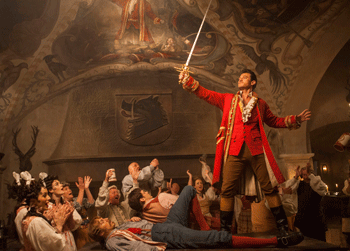 s bedroom and sprinkles it onto the dress. The dress, which took over 12,000 hours to make and of which multiple copies were made, did not require a corset or cage so as to give Emma Watson a greater amount of movement, as this Belle is more active than the Belle from the animated ï¬lm.
s bedroom and sprinkles it onto the dress. The dress, which took over 12,000 hours to make and of which multiple copies were made, did not require a corset or cage so as to give Emma Watson a greater amount of movement, as this Belle is more active than the Belle from the animated ï¬lm. 'It was deï¬nitely an interesting challenge," says Emma Watson, 'The dress itself is so iconic because it is part of that romantic scene in the story. The dress went through a lot of different iterations, but, in the end, we decided the most important thing was that the dress dance beautifully. We wanted it to feel like it could float, like it could fl y."
Durran agrees, saying, 'We actually took this into consideration when designing all of Belle's costumes. We didn't want her to be a delicate princess but an active heroine, so the blue dress and apron she wears at the beginning of the ï¬ lm was designed with pockets where she could place a book and to be worn with bloomers and a bodice."
This Belle is seen working with and riding her horse, Philippe, and wears boots in those scenes (as opposed to delicate feminine shoes). 'We really wanted to expand Belle's persona in the ï¬ lm and wanted to make sure she came across as a genuine equestrian and horsewoman," says Watson, 'So we made sure she had proper footwear and hiked up one side of her skirt so she could ride western style and that it looked easy for her."
The design on the gown Belle wears at the end of the ï¬lm, once the spell has been lined, is a print taken from an original 18th century apron that Durran bought when she was a student. The design was hand painted on a canvas and enlarged and printed digitally. 'The expectations for all of Belle's costumes were quite high," says Durran, 'But we ended up with some beautiful dresses that reference the animated ï¬ lm but are still unique to this one."
'One of the wonderful things about working with Jacqueline is that she is so incredibly collaborative," says Emma Watson. 'I was just blown away by how much input she wanted from me…she really wanted to understand how I perceived the character inside and out. It was such a special experience for me as an actress, and such a great way to build and understand a character through that process."
For the Prince's costume worn in the opening sequence of the ï¬lm, Durran created a coat and waistcoat embellished with thousands of Swarovski crystals, which was then scanned by the visual effects department and applied to the computer-generated Beast.
'Jackie is a goddess," says producer David Hoberman. 'She had a really tough job, not only because of the sheer volume of costumes in this movie, but because of the iconic wardrobe from the animated ï¬ lm.
She wanted to take into consideration and be somewhat faithful to the costumes worn by all the animated characters, but wanted to create something original as well, and she managed to come up with something completely beautiful and completely her own."
'Beauty and the Beast" is cinematographer Tobias Schliessler's fourth collaboration with Condon, and while the production did offer many challenges, there was ample room for creativity. Employing a range of camera equipment from a techno-dolly to a drone, Schliessler was constantly having to adapt, and it was an environment in which he thrives.
In some cases he chose to take iconic camera work from the animated ï¬ lm and add some of his own flourishes. For instance, the shot from the musical number 'Beauty and the Beast" where the camera sweeps over Belle and the Beast and travels up to the ballroom ceiling… Schliessler does the same camera sweep with a crane but then moves the camera up to capture the musical instruments carved from wood on the walls of the ballroom as they magically come to life and begin playing.
Filming the spectacular Busby Berkeley-esque musical number 'Be Our Guest" was challenging from a technical standpoint, and took one month to shoot, six months to prep and over a year to complete. The scene takes place in the dining room of the castle, which was designed like a stage, as it is the most theatrical set in the ï¬ lm. All the elements were real and shot in camera with the use of a techno-dolly, a crane and other special lighting equipment before the footage could be animated and augmented by the visual effects team in post-production.
'The interplay between the photography and the phenomenal design work on these sets has been incredible to see," says co-producer Greg Yolen. 'We built the foyer and ballroom of the castle – as they would actually be laid out – across two soundstages, and Tobias knew exactly where to put the camera to take full advantage of that."
Yolen continues, 'The depth he was able to capture of these two huge practical sets truly makes you feel like you are there."
Behind the Magic on Screen
One of the keys to a successful live-action adaptation of 'Beauty and the Beast" lay with the Beast. The cursed creature has to look somewhat believable and be someone with whom the audience will care for, but the technology needed to pull off such a feat did not exist until recently.
To create a realistic looking Beast in a real-world environment while maintaining Dan Stevens' performance, a combination of physical performance capture and MOVA facial capture technology was used. For the physical performance capture portions, scenes of the Beast with the live-action cast members were ï¬lmed on practical sets with Stevens wearing stilts and a prosthetics muscle suit with a gray bodysuit on top. Scenes of the Beast with the animated household staff were ï¬lmed with Stevens wearing a fractal gray bodysuit with visual effects indicators. And despite the restraining, the actor is able to convey a complex range of emotions, which was crucial, as the Beast is the romantic lead and the emotional center of the story.
Says director Bill Condon, 'Dan brings such warmth and nuance to the character and was able to evoke all of the pain and the humanity that was still there and give a powerful performance, which is told predominantly through his eyes and voice. It was really quite astonishing."
Stevens also participated in separate MOVA facial capture sessions which took place in an off -site studio. At these sessions, phosphorescent makeup was applied to Stevens' face, which appeared blue under ultraviolet light, and he was then ï¬lmed by multiple cameras surrounding him and tracking every pore in his face. The MOVA customized hardware and software then converted the performance into data.
'It was especially challenging," remembers Stevens, 'As you have to think back to scenes already ï¬lmed and move just your face, not your body, whether you had any dialogue or not. There was one instance where I had to do the entire ballroom waltz with just my face, which was quite interesting."
As for the household objects that magically come to life, each one has human-grounded characteristics and a speciï¬c personality. In fact, Condon referred to them as live-action actors throughout production. The objects are in close proximity with the human actors and are often shown interacting, but it was a laborious and signiï¬cantly time consuming process.
The ï¬nal footage audiences see on screen is real and ï¬lmed in camera and then augmented by the visual effects team during post-production. In order to create flawless assimilation with the computer- generated characters on practical sets, a solid hero model of each object – everything from a beautiful hand-painted teapot to a Rococo gilded candlestick – was created, each painstakingly detailed by the art department with reference to the original animated characters. Duplicate copies were also made, as were rubber versions for use in scenes involving stunt work, and once Condon and the visual effects team were pleased with appearances and proportions, the objects were then placed on set and ï¬lmed as part of principal photography.
For Stevens, the scenes with the Beast and the household objects also took a great deal of imagination on his part. He explains, 'I would walk on the set to ï¬ lm a scene where I am speaking to Lumière but I would be looking at an LED light on a stick and hearing Ewan's voice. It was lik
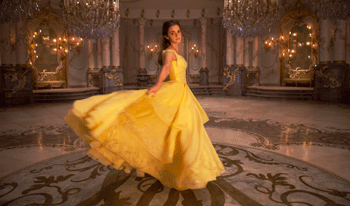 e an extra level of weird that we had to deal with."
e an extra level of weird that we had to deal with." For the design of the mantel clock, Cogsworth, played by Ian McKellen, the base and main box were made from polyester resin and painted gold. The exterior pieces were gold plated, the face was made from brass, and it was ï¬tted with proper clock movements to make the ticking and movement of the weights authentic.
The candelabra, Lumière (Ewan McGregor), is one of the few household objects that could open up and become a moving character with what are essentially arms, legs and hands, and the ï¬lmmakers wanted to bring as much of McGregor's personality to the character as possible. McGregor was ï¬lmed dancing and moving the way he envisioned Lumière would move, via performance capture technology.
'Lumière was difficult to concept because we wanted him to be able to move, but at the end of the day he's still a gilded candlestick," says visual effects producer Steve Gaub. 'Once we had a 3D computer model of him that everyone was happy with, he was constructed from a process called rapid prototyping which is able to take 3D computer ï¬ les and produce an accurate model in polyester resin so you can physically see and feel it."
The same process was used for the teapot, Mrs. Potts (Emma Thompson): she was designed via computer, prototyped and then molded.
To bring Garderobe (Audra McDonald) to life, a real version of the beautiful – and enormous – wardrobe was created and rigged to make her move. Additional special eff ects elements, like those in the scene where Garderobe creates Belle's gown and dresses her, were then added in post-production.
The costumes for the human versions of the household staff were designed collaboratively with the art and set decorating teams, ensuring elements of the human costumes mirrored their objects. For instance, Durran designed Cogsworth's human costume with buttons that were enameled with Roman numerals like the numbers on the mantel clock, and the embroidery design on his waistcoat and his epaulets match the design on the clock. With Mrs. Potts, the cream-colored base of the teapot is the color of her gown and the leaf print pattern on the teapot is incorporated into her gown as well.
The same was true for the the hair and make-up styles for the castle staff once they have been returned to their human form. Make-up and hair designer Jenny Shircore worked closely with Greenwood to pull out relevant details from the designs of the household objects so as to incorporate them into the hair and make-up designs.
Cogsworth has a clock-shaped head and a mustache that resembles clock hands; Garderobe's caged wig is similar in style to the top of the wardrobe; and Lumière's bounteous hairstyle was inspired by the design of the candlestick.
The beautiful music boxes Maurice creates were all crafted by hand with incredible gilded castings. They were inspired by the works of goldsmith Johann Melchior Dinglinger and depicted different cities and countries from around the world. Because they exist in an enchanted and magical environment, these are not just music boxes, but portals to other worlds.
Enhancing the Classic Score
In addition to building upon the story from the animated classic, director Bill Condon believed that, musically, the story could move in a slightly more realistic direction, either by ï¬nding interesting variations on the existing songs or with the addition of new songs. Songs help tell a story and elevate its emotional content, while at the same time helping push the story forward. 'At the end of a song, you should feel as though you've arrived somewhere different from where you started," explains Condon. 'Otherwise it feels like the story just stops."
'Part of Bill's approach was to take the music from two dimensions to three dimensions, both literally and in terms of the characters," says composer Alan Menken. 'He has a keen understanding of the romance at the center of the story and how important that is, but also realizes that it is spectacular in and of itself, with talking candlesticks and dancing clocks at the same time."
Says Condon, 'Alan is so generous, because I was ï¬lled with so many ideas and things I wanted to play with and it was all so new and exciting for me, and he just dove right in, not only writing three new songs but also rethinking some of the old ones. It was thrilling and inspiring to work with him and to just see how alive this is for him."
'Alan and Howard wrote the original music for the animated ï¬ lm, but when it came time to adapt the music for the Broadway production, Howard had, sadly, already passed away," says Bill Condon. 'That's when Tim came on board, so both Alan and Tim have been involved with this project for quite some time, which is very fortunate for us."
'Well I was extremely lucky," says Tim Rice, 'And I still feel somewhat in the shadow of the great Howard Ashman on this project because he was a brilliant lyricist who was cut off in his prime. But I'm also a great fan of Alan because I've seen -Little Shop of Horrors' and -The Little Mermaid' and I love -Beauty and the Beast.'"
The ï¬lmmakers have the utmost respect for the animated ï¬lm's score and its memorable songs, like the rousing opening number 'Belle," the delightful duet 'Something There," the enchanting ballad 'Beauty and the Beast" and the jubilant show-stopper 'Be Our Guest," each one with a beautiful and haunting melody from Menken and sophisticated lyrics from Ashman.
'I love that the music has this kind of classical, theatrical feeling to it yet still seems somewhat modern," says Emma Watson. 'It rides that perfect line where it's not pop music and not stage music…it's kind of that perfect sweet spot in the middle, and it's just really magical."
Luke Evans agrees, saying 'I come from the world of musical theatre so I feel very passionate about telling a story with music and lyrics, and what these geniuses did back in 1991 was tell a story which was very, very old and make it appeal to everyone. It has left a lasting impression on many generations of ï¬lmgoers."
The new songs written by Menken and Rice are telling new parts of the story, taking the story in new directions and ï¬tting seamlessly into the fabric of 'Beauty and the Beast." In addition, some of Howard Ashman's original lyrics from the songs 'Gaston" and 'Beauty and the Beast" not used in the animated ï¬ lm have been added back in to the ï¬ lm as well.
The music from the animated ï¬ lm is perfect as is, so there was never any discussion about cutting any of those musical numbers for the live-action adaptation. The music for the Broadway production is equally as brilliant, and while Bill Condon would have liked to have incorporated some of those songs in this ï¬ lm, they were written speciï¬cally for the stage and ï¬ t a theatrical format, not a cinematic one.
'There's a wonderful ballad that the Beast has, -If I Can't Love Her,' that's become iconic in its own right, but it's a first act curtain number," says Bill Condon, 'So in looking at that and looking at the ways we expanded the backstories of the Prince/Beast and Belle, it became clear that there were three important spots where we needed new songs."
One of the new songs is a soaring ballad performed by Dan Stevens as the Beast entitled 'Evermore," which he sings after releasing Belle from the castle to be with her father, despite the fact that his heart is breaking. 'Dan came such a long way and has become a wonderful singer," says Menken. 'He's got this amazing baritone voice and he really knocks it out of the park."
'Days in the Sun" is a heartwarming song performed by the characters in the castle as they are getting ready for bed and are thinking about the old days. 'It's a song about longing and how everyone in the castle is brought together by the awful heartache of missing something or someone that they deeply love and care about," says Watson. 'It kind of takes you through all the different characters in the castle and lets you hear their internal thoughts at that particular juncture."
Stevens adds, 'The song has a classic feel to it and really makes you yearn for something. Working with Alan has been quite an experience and it's a pleasure to have such wonderful material to work with."
'How Does A Moment Last Forever" is a beautiful ballad about holding onto life's precious moments that is sung by Maurice (Kevin Kline) while designing a music box. The music box represents the perfect childhood his daughter never had and gives the audience a glimpse into Belle's unknown past. 'This is an incredibly emotional new beat for the story, and for anyone who cares about the story it will really ring true," says Condon. 'It has the same wonderful musical qualities that the other songs do, and I think this song really sits right beside the originals in that you can't get them out of your head."
The melody appears numerous times throughout the score, beginning with Maurice's solo and followed by a reprise performed by Belle (Watson) later on in the story and then yet again over the end credits.
Bill Condon and Menken were both in agreement that Emma Watson's singing comes from a place of strength. Her frustration at feeling trapped and wanting to get out and experience all life has to offer is a story in and of itself, and, because she knows and understands the character so well and she had rehearsed all her scenes before pre-recording the vocals, she sounds completely natural.
For Emma Thompson, singing 'Beauty and the Beast" was an amazing experience, but an intimidating one as well. 'Angela Lansbury was a bit of a tough act to follow," she says, 'And I can't even begin to sing it nearly as well as she does, because she has such an iconic voice. I just hope I can give a vague or at least a very human and heartfelt version of it for this new generation coming up."
She continues, 'Alan Menken is just extraordinary. His songs go right into your heart and you hear them again and again and again and you never tire of them." Producer David Hoberman says, 'When we were shooting that scene and the beautiful melody from -Beauty and the Beast' was played back on set, I remember thinking, I really do believe we may have shot the most beautiful romantic scene ever put on ï¬ lm. The camera moves that Tobias brought to it, the set decoration, the choreography…everything just sort of fell into place in that ballroom."
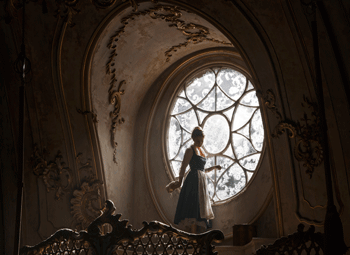
The actors were always mic'd, even when singing to playback. The human characters recorded their vocals and dialogue leading into the musical numbers prior to principal photography. The enchanted characters were pre- recorded and their recordings used as a guide track when shooting. Then in post-production, once the visual effects were completed, they recorded their tracks to match the exuberance on the screen.
Be Our Guest
The live-action adaptation of Disney's animated classic 'Beauty and the Beast" is a stunning, cinematic event celebrating one of the most enduring and beloved tales ever told, and one that has touched readers for centuries. Now, thanks to the artistry and imagination of director Bill Condon and a brilliant creative team, audiences of all ages are sure to be captivated by the story's adventure, passion and romance once again.
According to Condon, 'The delightful animated ï¬ lm from 1991 plays as classic animation, but if you want to go a level deeper into the story and into the songs and into the emotions, that's what this live-action ï¬ lm delivers: a greater depth of emotions."
'It's rare during principal photography when everyone on set is happy, but on this ï¬ lm where we had hundreds of people on set every day, everyone was genuinely pleased to be there," says Ian McKellen. 'Many of them had been working since the early hours of the morning, but I never heard a single word of complaint from anyone, technician or performer, and that speaks very well for the ï¬lm."
'I feel very lucky to have been given the chance to work with this material," says Bill Condon. 'There's something about this story – and speciï¬cally the score, which was written 25 years ago – that is just magical, and I think that's what still draws people in and is what makes this such a special experience."
Beauty and the Beast
Release Date: March 23rd, 2017
Trailer
MORE





